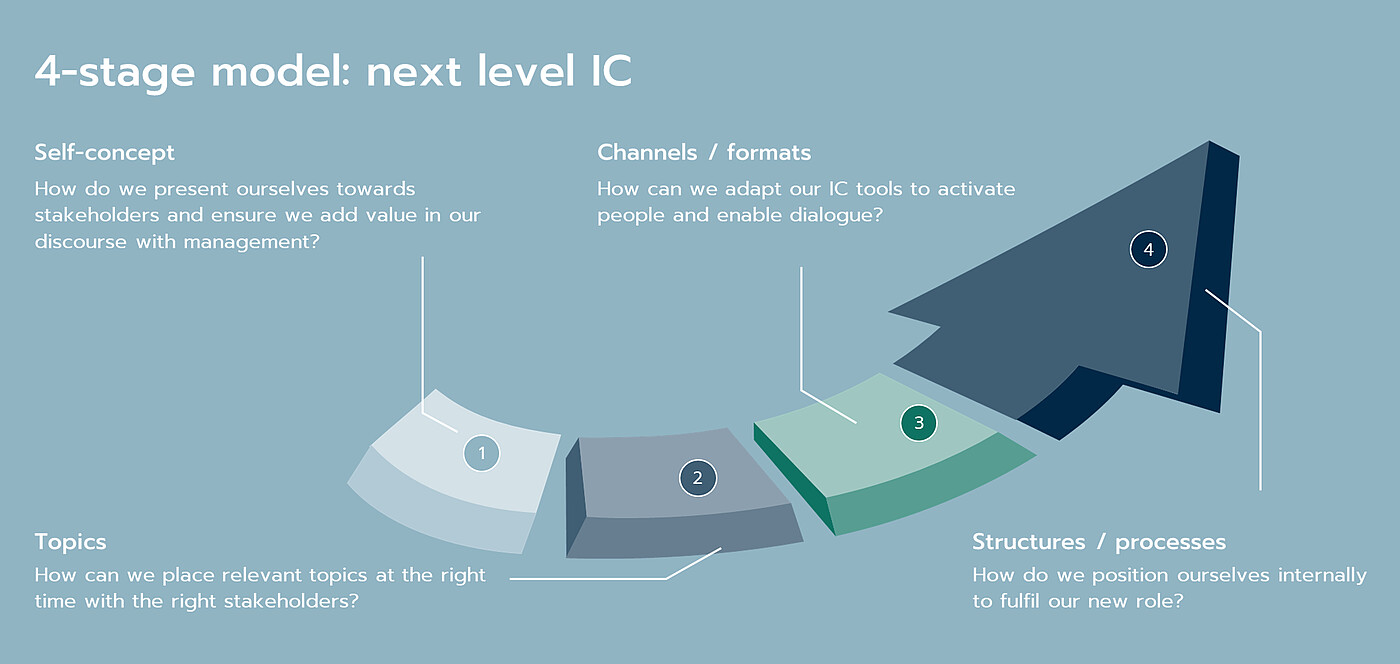by Julika Benz
Due to the current challenges associated with transformation processes, Internal Communications teams now have the opportunity to step up to become more involved in shaping the development of their companies . If they do this, they are likely become a valuable advisor to top management. A decision to expand their current role needs to be made to move in this direction and an actively managed process should be put into place that aligns topics, channels and structures with the envisaged tasks.
Once the Internal Communications managers have decided that they want and are able to take on more responsibility in helping a transformation process to succeed, the important first step has already been taken. Because now they can work out how they want to achieve this.

In consulting practice, a four-step model has proven successful, which starts with defining “self-concept” more clearly. The important questions here are: How do we present ourselves externally? What value can we add to the strategic discourse? What crucial decision-making information do we have exclusive access to? How do we shape our interaction with management and at other key interfaces? The answers to these questions should be shared with the entire team and become key criteria in day-to-day decision making. They also determine to a large extent how the Internal Communications team deals with key matters such as topics, channels and formats as well as its own organisational structure.
The IC agenda is then reviewed to find out to what extent it supports the strategic topics of the company. Planning of strategic issues requires an in-depth understanding of how the corporate strategy was developed as well as of short- to medium-term strategic challenges. In particular, however, it is important to gain a feeling for how those issues impact the organisation directly. In order to come up with the right ideas at the right time in the dialogue with management, it is thus always essential to listen to the employees and their needs. This makes IC a valuable advisory mediator between strategy development and implementation and ensures a continuous and, above all, relevant top-down and bottom-up flow of information.
In stage three, a critical look must be taken at the available communications channels and formats. Channels that go beyond the usual reporting tools are required to inform, enable and activate managers. In addition, an attempt should be made to structure informal dialogue within the company. It has been shown that interactions between managers and employees, as well as those between employees themselves, are the ones that bring about lasting interest in topics as well as making changes in their own behaviour more likely. These informal channels that are not directly accessible are particularly promising in terms of the Internal Communications department’s contribution towards the success of the transformation process. Ambassadors or corporate influencers can be used in this process. Companies need to develop the art form of using of peers who can provide information and help make sense of as well as advocate topics.
Lastly, the internal structure of the IC team must accommodate the new role and the tasks associated with it. The team needs to position itself within the triangle of topics, internal stakeholders and channels. Often, it is well thought-out processes that enable effective and efficient positioning. However, this requires a thorough review and, in many cases, calibration of the team’s value chain. Some of the questions that need to be asked to guide this process are: Who is responsible for perception analysis? Is organising major internal campaigns a separate area of responsibility? Should just one person be responsible for engaging and enabling managers? But also: What skills are we lacking as a team to be able to authentically fulfil our envisaged role of advisers (strategic-conceptual, for managing agencies etc.)?
As strategic communications advisors, it is part of our daily business to support Internal Communications teams. Let’s work together to realise the full potential of your Internal Communications department and make it a team of advisors at eye-level with top management.
Photo: iStock.com/EasyBuy4u
Contact

Director

 LinkedIn
LinkedIn
 Twitter / X
Twitter / X
